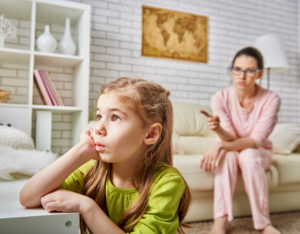When Moms and Kids Have ADHD

Parenting is a difficult role, and few of us are trained for it. When you add Attention Deficit Disorder (ADHD) to the mix, parenting becomes even more challenging. Because ADHD is highly heritable, it has been estimated that between 40-60% of children with ADHD have at least one parent with ADHD.
While many books have been written about raising a child with ADHD, the parenting advice they offer is often inappropriate when the mother has ADHD, as well. One mother with ADHD succinctly described her challenge, asking, “How am I supposed to organize my child when I can't even organize myself?”
Article continues below...
Treatment for your Child's ADHD
Download a free tip sheet "Recommended Treatment for ADHD: Medication & Behavior Management" for what's really recommended for your child or teen.
What's the First Step for a Mom with ADD/ADHD?
Moms with ADHD need support. In fact, Moms need to learn to manage their own ADHD before they can be successful in helping their child meet the challenges of ADHD. If you are a mother with ADHD, your first step should be to get treatment for yourself.
However, a mother's usual tendency is to focus on her child's difficulties, while neglecting her own. Just as the airline flight attendant instructs you to put on your own oxygen mask before assisting your child, you must first get help for your own ADHD before you can effectively deal with your child's problems. A recent study suggests that parent training programs are not very helpful when the mother has untreated ADHD, lending even more weight to the importance of treatment for women with ADHD.
ADHD is a Family Affair: How to Become ADHD Friendly
Everyone is affected when several family members have ADHD, and all need to work together to create an ADHD-friendly family environment. In that environment:
- each family member can feel and function better
- the negative impact of ADHD is minimized
- the gifts and talents of each family member are nurtured
An ADHD-friendly family is one that solves problems and celebrates successes together. Instead of only focusing on a child's or mother's ADHD problem-behaviors, here's how to find creative solutions that involve the entire family.
-
- Learn about ADHD as a family. Watch a video, check out a website, or read a book on ADHD together. It's important to talk about ADHD and what it means to family members who have the diagnosis, and those that do not. Everyone benefits by being open and having the opportunity to talk about the impact of ADHD.
-
- All family members should take part in finding solutions when problems arise – not just those with ADHD. Since everyone is affected when several family members have ADHD, everyone needs to work together to create an environment in which each family member can feel and function better. Instead of only focusing on a child's ADD problem-behaviors, it's important to work together to find creative solutions that involve the entire family.
-
- Give yourself and your family a break! Let go of unrealistic expectations and set goals that are right for you and your family. Set family goals for getting organized and solving the problems of daily life. Look for therapists, coaches and organizers who can work with you and your family to create a more ADD-friendly home environment. If you're like most ADHD families, there are lots of areas that need to be organized or changed. Be careful not to take on too many projects at once. Build on your successes, one area at a time.
-
- Practice healthy habits as a family. Exercise, play, and eat nutritious family meals together. Getting the whole family to bed on time can help reduce the negative impact of ADHD.
-
- Focus on what's important – being loving, encouraging and cooperative within the home. Together you can learn to love life and achieve great things.
-
- Make your home a safe haven - a place where each family member feels loved and supported.
-
- Don't sweat the details - like who left the wet towel on the bathroom floor.
-
- Be patient. It's easier to keep trying when you feel that your family is behind you.
-
- Learn to laugh. Humor eases the way through inevitable daily ADHD glitches.
-
- Spend time enjoying each other. Don't just “work” on problems. Have a picnic dinner on a week night instead of eating at home or go out for ice cream “just because,” not as a special treat or something that has to be earned by good behavior.
-
- Accommodate family forgetfulness with notes, message centers and user-friendly reminders.
-
- Create a family philosophy that it's OK to be different! Find posters or inspirational sayings and post them around the house, or text/email to each other.
-
- Focus on the positive. Come together as a family and create a list of 5 things you appreciate about yourself and/or your family. Maybe it's reading a bedtime story or having a child help with the dishes or brush his teeth without a major tantrum. By consciously bringing these positive moments into your awareness and appreciating them, you will begin to feel renewed energy and hope.
-
- Rely on the power of routines. All kids feel safe when they know what to expect on a daily basis. Daily life in many families with ADHD members can be chaotic. Developing daily routines, particularly a “morning routine” and an “evening routine,” can help your family be more orderly. Work on developing these routines as a family and problem-solve as a family when a routine isn't working – supportively, and without judgment.

